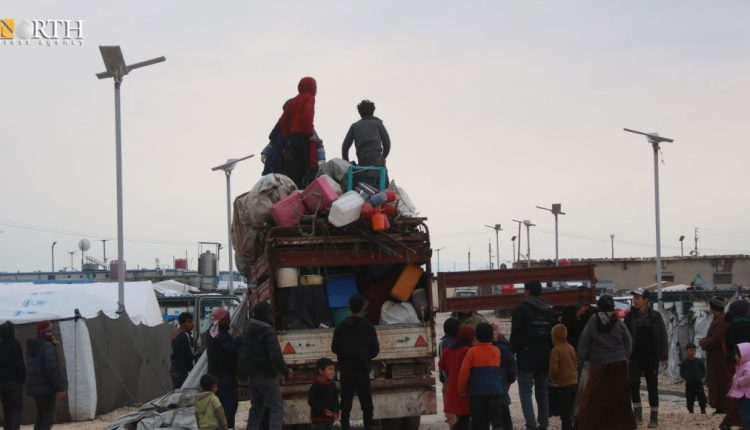
By Dilosoz Youssef
HASAKAH, Syria (North Press) – After a rainy night, 70-year-old Khalil al-Faraj finished packing his belongings in al-Arisha IDP camp, located in the southern countryside of Hasakah, northeastern Syria, preparing to return to his hometown in Deir ez-Zor, eastern the country, after eight years of displacement.
On Feb. 11, hundreds of families departed the al-Arisha camp for their homes on the western bank of Deir ez-Zor, following a decision by the Autonomous Administration of North and East Syria (AANES) allowing displaced Syrians to return after the fall of the Assad regime.
A Journey into the unknown
Standing beside the truck that will carry his belongings, al-Faraj, wearing a headscarf and sporting a graying beard, expressed his bittersweet feelings. While he is eager to return to his land and erect a tent over the ruins of his home, his joy is tempered by the uncertainty of what awaits him—his house destroyed by war and job opportunities scarce.
“Now, I am returning to my hometown, where I will set up a tent on the site of my destroyed house,” said al-Faraj, who hails from the village of al-Merei’iyah near Deir ez-Zor Airport. “I hope that one day, humanitarian organizations will assist in rebuilding my destroyed house.”
Prolonged displacement
Tens of thousands of displaced Syrians from different regions have taken refuge in camps across northeastern Syria, having fled their homes due to the decade-long conflict. Although battles have subsided in recent years, fear of arbitrary arrests by the former regime has prevented many from returning home—including al-Faraj and his family.
“I could have gone back earlier, but my sons would have been arrested due to conscription and other issues,” he explained. “Last year, I returned briefly and tried to cultivate my land, but the high costs and harsh living conditions made it impossible.”
Overwhelmed by emotion when asked about his feelings on returning home after so many years, the elderly man struggled to hold back tears. “Our children have emigrated, and those of us who remain do not know what our future holds,” he said.
According to the UNHCR, over 7.4 million Syrians were internally displaced before the fall of the Assad regime. More than two million live in camps, while over five million reside elsewhere.
Mounting challenges and uncertainty
Although some displaced families have returned home, many face significant obstacles, says Sumayyah Ahmad, another displaced resident from al-Merei’iyah. She has moved between several areas over the past eight years, eventually settling in al-Arisha camp.
Ahmad expressed concerns about returning to her bombed-out home, citing the presence of landmines and the absence of basic services such as water and electricity. “Life there is nearly impossible,” she said.
Like many others, Ahmad is eager to return home, especially after humanitarian aid from U.S.-affiliated organizations was recently cut. “Aid has stopped, and work opportunities are scarce. We want to go home, but we don’t even have a tent, and our financial situation is dire,” she added.
The deteriorating conditions in the camp have pushed many to consider returning, despite the uncertainties. Mahmoud al-Abdullah, also in his seventies, described similar hardships. His house was destroyed, and he left behind all his possessions when he fled.
“Conditions in the camp have worsened, but I cannot return because I have no place to live and no work opportunities back home,” al-Abdullah said.
The fall of the regime opened a window for displaced families to return, but the realities on the ground remain harsh. “Most homes are in ruins. We need tents to shelter our families and help to rebuild our lives. Living conditions are tough, and agriculture is our only livelihood, but we have no fuel for irrigation,” he explained.
He also recalled the fear of arbitrary arrests and corruption under the former regime, which had previously prevented their return.
While the displaced express joy at the prospect of returning to their hometowns, rebuilding their lives remains the greatest challenge ahead.
